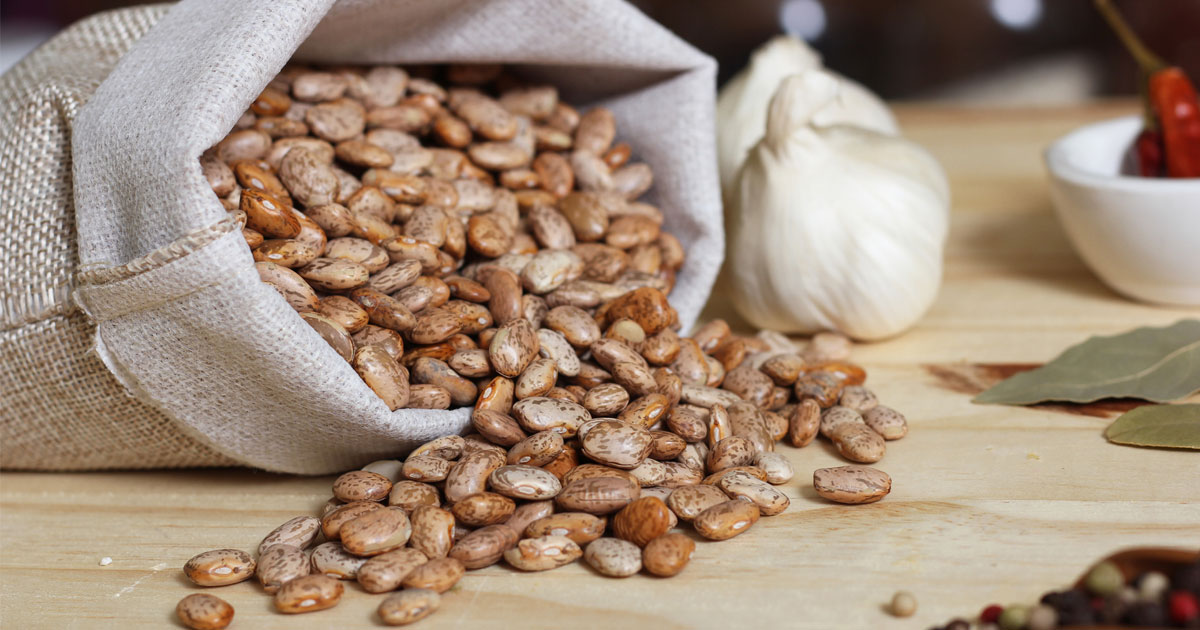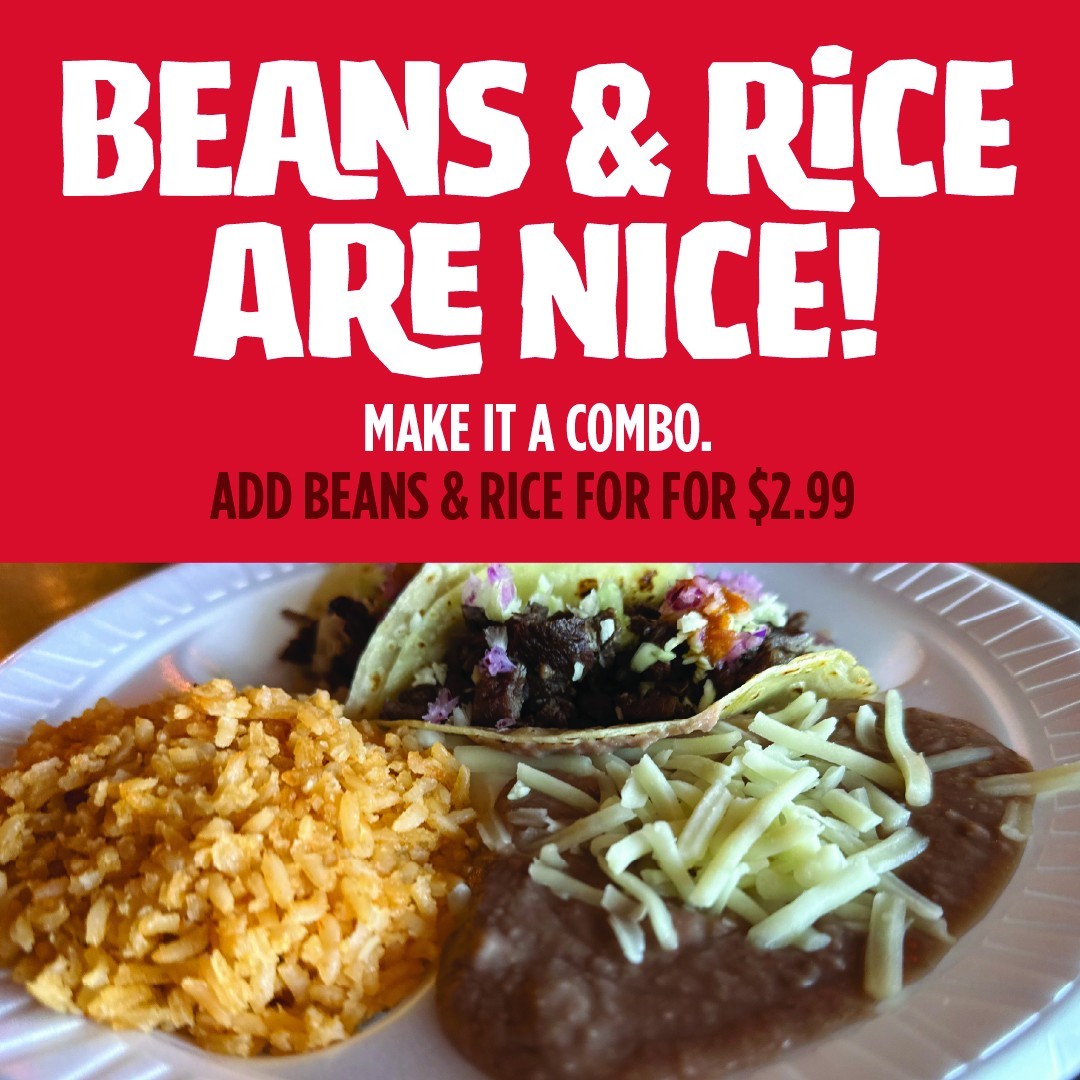Make it a combo at Backyard Taco!
You read that right: we are now offering the option to upgrade your favorite dish by adding beans and rice for just $2.99. Beans and Rice are extremely nice and make for the perfect addition to any of our delicious meals. In fact, beans and rice are to our authentic Mexican dishes as fries are to burgers: the ideal companion. So, just tell us to “Make it a Combo” at any of our six Backyard Taco locations, and we promise you’ll love the extra taste of Mexcellence!
The Ancient History of a Perfect Pairing
While food is a necessity to nourish our bodies and minds, food serves another, just-as-important function – to be enjoyed and experimented with. Over the millennia, human cooks have discovered that there are just certain ingredients that are a match made in heaven, and we think beans and rice are one of those pairings. Maybe that’s why beans and rice, in many variations, have been a staple dish across different cultures for centuries.
It is believed that the pairing of these ingredients may have originated in Africa, eventually finding its way into the Americas during the slave trade. Once introduced to the Americas, beans and rice became not only a staple food but a symbol of identity and culture in the southernmost parts of the two continents. In Central America, this combo is often called “Matrimonio,” meaning “the marriage,” and we believe it’s fitting because this union is simply so perfect when enjoyed together.
Beans and rice together have an impressive history, especially when it comes to Mexican cuisine. However, even separately, these ingredients have some history worth exploring.
All About the Beans
Beans have a rich history around the globe, especially in Mesoamerican civilizations. Beans held both cultural and symbolic significance there, as they were associated with sustenance, fertility, and the cycle of life. In many ancient cultures, beans were considered a gift from the gods, ensuring that they would be a staple in many diets. As an excellent source of protein, beans provided the fuel people needed for travel and labor.

Over years of change, such as the arrival of the Spanish Conquistadors in the 16th century, beans continued to provide a stable source of protein and flavor. While the Spanish provided significant influence over Mexican cuisine due to the introduction of new, exotic ingredients, beans remained.
The Value of Beans
Beans are extremely versatile. This allows them the ability to adapt to a variety of regions and climates. In addition to their growing versatility, beans are versatile in the ways in which they can be enjoyed. Beans are commonly found in a wide range of soups and stews and can also be enjoyed in side dishes such as the ever-popular beans and rice combo. Beans are affordable, provide nutritional benefits, and provide a rich flavor.
Type of Beans
There is no one-size-fits-all when it comes to beans. There are numerous bean options, all of which provide their own unique flavor and texture. Mexican cuisine is especially known for its diverse and vibrant flavors, and the beans chosen make a significant impact on the final outcome.
Some of the most commonly featured beans include:
-
- Pinto Beans – When cooked and mashed, these beans make the perfect base for refried beans and can often be found in a variety of hearty soups. They are best known for their earthy flavor and creamy texture.
- Bayo Beans – These beans are a popular choice for stews and soups as they absorb flavors well. They provide a mild flavor and creamy texture, often paired with pork or beef.
- Black Beans – Black beans are loved for their bold flavor. While often used as a base for numerous classic Mexican dishes, they can also be pureed and used as a sauce or filling.
- Canario Beans – These beans are extremely versatile as they are creamy and mild flavored. They are used in a wide range of Mexican dishes.
- Other noteworthy beans include Peruano Beans, Flor de Mayo Beans, Azuki Beans, Mora Beans, Flor de Junio Beans, and Anasazi Beans.

Who would have thought beans could be so versatile? Each type of bean brings a unique flavor and texture, adding to the diversity of this cuisine.
All About the Rice
It’s hard to picture ordering a Mexican dish like a burrito without automatically adding rice to your concoction. Rice has long been established as a must-have side to numerous popular dishes. The history of rice in Mexican cuisine can be traced to Spanish colonization; after being introduced in the 1500s it found a home in Mexican culture. Historians are not altogether certain why this grain turned out to be such a hit, but the results are undeniable in the cuisines we know and love today. But while Spain may have impacted rice’s introduction to Mexican cuisine, their use of rice was in itself a product of trade, and the journey of rice can be traced from Asia and through the Middle East before it ever arrives on North or Central American shores.
Mexico would prove to be a fertile location for rice growing, and the ease with which rice could be produced led to the incorporation of this diverse grain across several dishes. Mexican rice (which does differ from Spanish rice) is a product of adaptation, experimentation, and cultural exchange. Mexican rice will often include ingredients such as tomatoes, peppers, and onions. It’s important to note that Mexican rice is often made using long-grain white rice, though brown rice can work just as well. The exact ingredients and seasoning may vary depending on the needs of the dish, but it is common for Mexican rice to be red in color, as tomato paste or other tomato products are a common ingredient.
Spanish Rice Misconception
It is not uncommon for the term Spanish rice to be used interchangeably with Mexican rice. This is largely due to the fact that these two dishes often share a number of the same ingredients. Still, there are major differences, including texture, aroma, and flavor. Mexican rice tends to be softer in texture, with a pleasing, mild aroma. It is also most commonly red in color. Spanish rice tends to be firmer, has a stronger aroma, and is often yellowish in color.

The Health Benefits of Beans and Rice
Beans and rice are not only a delicious combo, but they are a great option for your health. When combined together, these ingredients contain all nine essential amino acids and are an excellent source of protein. In most instances, you can expect around 12 grams of protein per cup consumed. This can be especially beneficial for individuals who want to cut back or eliminate meats in their diet but want a trusted protein source. Beans and rice have long been a staple for dishes looking to provide energy and sustenance.
Beans and rice are also high in fiber. Fiber helps to regulate blood sugar and is good for digestion. Adding beans and rice to your diet can even help you lose or maintain a healthy weight because these two ingredients help you stay full longer. This helps prevent the temptation to snack throughout the day. When you want fuel for your day, make it a combo at Backyard Taco.
Make Your Meal a Combo Today!
There are many reasons numerous cultures have enjoyed beans and rice for centuries, and we celebrate all of them at each of our six locations. Beans and rice continue to be a food staple due to their affordability, versatility, and health benefits, so they hold a special place in the heart of Mexican cuisine.

At Backyard Taco, we are committed to ensuring our customers not only get to enjoy a delicious meal but can leave feeling sustained and energized. Whether you are ordering in or driving through one of our 6 locations, just tell us to “Make it a Combo,” and you’ll be good to go!
Resources:
- Beans & Rice: An Ancient Staple Dish. (n.d.). Chef Soraya. https://www.chefsoraya.com/blogs/blog/beans-rice-an-ancient-staple-dish
- Beans in the Mexican Pantry. (2018, March 9). Camellia Brand. https://www.camelliabrand.com/beans-in-the-mexican-pantry/
- Thomas, J. T. (2021, January 6). Historias de la Cocina: Spanish Rice. The Interlude. https://medium.com/the-interlude/historias-de-la-cocina-spanish-rice-bf93eac7efc4
- Beans in Mexican Cooking: History, Types, and 8 Recipes. (n.d.). Www.munchery.com. Retrieved November 10, 2023, from https://www.munchery.com/blog/beans-in-mexican-cooking-history-types-and-8-recipes/

Dr. Tyler loves tacos! He is one of the owners of Backyard Taco, and can sometimes be found moonlighting there at night or on the weekends.
Dr. Tyler Robison is an alum of Mesa’s Mountain View High School. He graduted from Brigham Young University before being accepted to the “Top Ten-nationally ranked” University of Louisville in Kentucky, where he earned his Doctorate in Dental Medicine and a Master’s Degree in Oral Biology. He graduated with honors in the top ten percent of his class. Dr. Robison continued at the University of the Pacific in San Francisco, where he received a second master’s degree in dental science and his orthodontic certification.
Dr. Tyler enjoys serving in his community. He is a provider for the Smile Back Foundation, which offers scholarships for free dental treatment to underprivileged East Valley students. He is also a Major in the U.S. Army Reserve and served during Operation Enduring Freedom in 2008.
Dr. Tyler Robison’s favorite pastimes include spending time with his family on the lake, at the beach, or on the slopes. He is an avid and crazy snowboarder! He has three incredible sons and one sweet daughter: Caden, Jace, Crew, and Bliss.


